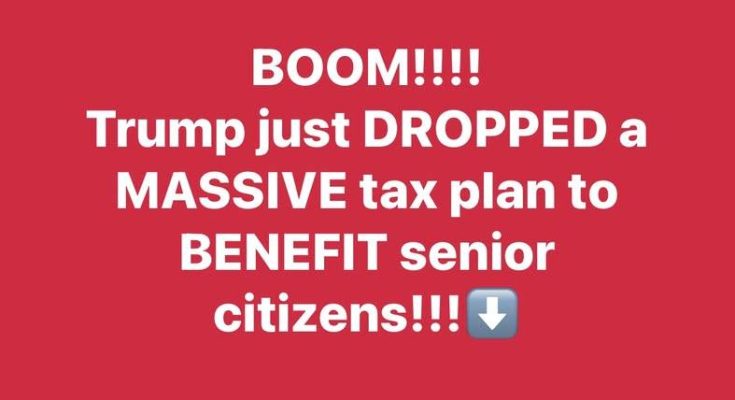This proposal, which is already igniting intense discussions throughout Washington, emphasizes the removal of taxes on tips, Social Security benefits, and overtime pay, measures aimed at increasing the disposable income of ordinary workers.
This declaration arises in the context of increasing worries regarding inflation, economic uncertainty, and the ongoing repercussions of the pandemic, which have exerted significant financial strain on American households.
Trump’s team asserts that these tax modifications will provide direct advantages to workers in service sectors, seniors on fixed incomes, and employees working additional hours to sustain their livelihoods.
Nevertheless, detractors contend that although some elements may appear beneficial to the middle class, the overall consequences of the tax reductions could predominantly favor corporations and affluent individuals.
An In-Depth Examination of the Principal Provisions Trump’s proposal encompasses several crucial tax policy changes designed to enhance economic growth, boost employment, and secure long-term fiscal stability. Among the most significant provisions are:
1. Abolishing Taxes on Tips, Social Security Benefits, and Overtime Pay The proposal eliminates federal taxes on tips, which would greatly benefit restaurant workers, bartenders, hairdressers, and other employees in the service sector who depend on gratuities for their income.
Trump’s campaign has framed this as a transformative measure for blue-collar workers.
Additionally, Social Security benefits would be entirely exempt from taxation, potentially providing substantial financial relief to millions of retirees who currently face federal taxes on a portion of their Social Security income.
By removing taxes on overtime pay, the administration aims to motivate diligent Americans to work extra hours without the concern of losing a significant portion of their earnings to taxes.
2. Addressing the Carried Interest Loophole A central element of the proposal is the effort to close the carried interest loophole, a longstanding tax provision that permits hedge fund managers and private equity executives to pay lower tax rates on investment gains compared to ordinary income earners.
Trump had previously vowed to eliminate this loophole during his 2016 campaign, but it remained largely unaddressed during his administration.
This time, his team is advocating for a more assertive strategy to create a fairer tax environment.
3. Prolonging the 2017 Tax Cuts and Jobs Act One of Trump’s signature economic initiatives during his first term was the 2017 Tax Cuts and Jobs Act (TCJA), which reduced individual tax rates, lowered the corporate tax rate from 35% to 21%, and raised the standard deduction.
The new proposal aims to extend these tax cuts beyond their original expiration date in 2025, contending that the removal of these reductions would impose unnecessary burdens on American households and businesses.
4. The proposal to reduce the corporate tax rate to 15% represents a significant shift, moving from the current rate of 21%. The administration asserts that this reduction will stimulate business investments, foster job creation, and deter companies from moving their operations abroad.
Nevertheless, opponents contend that such a tax cut may primarily advantage large corporations and exacerbate wealth inequality. Supporters, on the other hand, claim that a lower corporate tax rate will result in higher wages, improved employee benefits, and robust economic growth.
The Political Conflict: Democrats versus Republicans As anticipated, Democrats have pledged to oppose the proposal, denouncing it as yet another benefit for the affluent and a perilous fiscal strategy that could exacerbate the deficit.
House Minority Leader Hakeem Jeffries condemned the initiative, asserting: “This is merely another effort to divert funds into the hands of billionaires while neglecting working families. Abolishing taxes on tips may sound appealing, but this entire proposal serves as a Trojan horse for corporate avarice.”
On the Republican front, although many conservatives endorse Trump’s initiative, divisions persist within the party. Some fiscal conservatives express concern regarding the absence of spending reductions to balance the tax cuts, while others advocate for the vigorous extension of the TCJA and a decrease in corporate taxes.
Senator Rand Paul, a longstanding proponent of tax reductions, conveyed cautious endorsement, stating: “I appreciate the direction of this proposal, but we must be prudent about its funding. We cannot continue to reduce taxes without also cutting spending.”
Meanwhile, Trump supporters like Senator Josh Hawley are fully in favor of the proposal, contending: “This is about ensuring that the American worker receives a fair deal. The Biden administration has implemented policies detrimental to middle-class families, and President Trump is providing relief where it is most needed.” What Lies Ahead? The legislative struggle over this tax proposal is poised to become one of the pivotal economic confrontations of Trump’s presidency.
The plan must navigate through both chambers of Congress, where it will encounter rigorous examination, negotiations, and possible amendments. Given the divided government, obtaining bipartisan support will prove difficult, particularly with the contentious 2026 midterm elections approaching.
Legislators from both parties are likely to leverage this tax proposal to galvanize their voter base, rendering it a significant political flashpoint.



